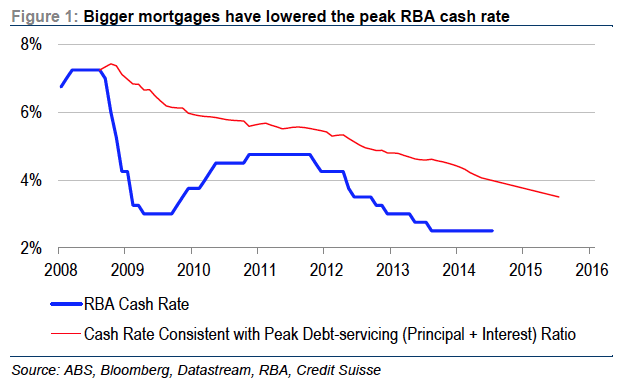While the latest minutes from the Reserve Bank suggest that rates will remain on hold for the next 12 months, rising principal home loan payments and shrinking disposable incomes will create GFC-like stress levels for borrowers if rates were to reach 3.5 per cent, according to Credit Suisse.
“Larger mortgages imply structurally high and rising principal payments – but disposable income is not keeping up,” the bank said.
“Consequently, households have less ability to withstand higher rates,” it said.
In a report released this week, Credit Suisse analysts Damien Boey and Hasan Tevfik estimate that household debt servicing payments are 21 per cent of disposable income, made up of 14 per cent principal and seven per cent interest.
The figure is trending upward, they said, and is only two percentage points away from hitting the GFC peak of 23 per cent.
“It would only take 100 basis points of rate hikes to bring the debt-servicing ratio back to GFC highs, which we view as unsustainable.”
Credit Suisse analyst Damien Boey admitted that he had been generous in his estimation, telling Mortgage Business that his numbers use a very simple proxy for principal payments.
“You could very easily construct a different measure of principal payments which will show that rates cannot be raised by 100 basis points before borrowers begin to feel GFC-like stress levels,” Mr Boey said.
Credit Suisse suggests that the peak in rates will likely be much lower than the previous peak, consistent with the global downtrend in rates in the inflation-targeting era.
“This is because household debt has risen much faster than disposable income, and the rise in leverage has caused a structural rise in principal payments,” they said.
“As principal payments have risen, the ability of households to tolerate higher interest payments has fallen, putting pressure on the RBA to keep interest rates lower for longer.”
Earlier this month, RBA governor forecast that the cash rate will remain at a record-low 2.5 per cent for at least one more year.
